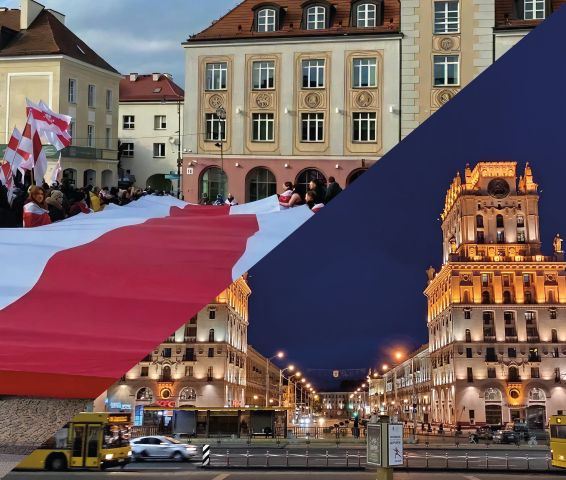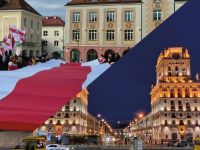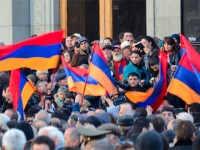Formula of Humanity study: “Lines of conflict among Belarusian pro-democracy activists (Belarus, Poland, Lithuania)”, June 2024.
Lines of conflict among Belarusian pro-democracy activists (Belarus, Poland, Lithuania)

Formula of Humanity study: “Lines of conflict among Belarusian pro-democracy activists (Belarus, Poland, Lithuania)”, June 2024.
The Belarusian protest movement of 2020 united a variety of groups that differed not only in socio-demographic parameters, but also in value orientations and political views. The diversity of the composition of those who took to the streets in August-December 2020 has been repeatedly emphasized by researchers as one of the features of the protest movement. It is important to understand that the processes of solidarization at that time embraced many people and social groups that previously had nothing in common with each other and were united only by the appropriation of a common situation. The situation included the accumulated discontent during the first wave of COVID, the “stolen” elections and the unprecedented violence during the crackdown on protests).
Massive expression of solidarity in an existential situation creates a special kind of connections between people (“horizontal sociality” by H. Korshunau) and a special kind of communities (“community of the dismayed” by T. Shchitzova). But the effect of solidarity can never be long-term. With the end of a “catastrophic” situation, the communities created by it either disappear or evolve. If the situation remains unfinished, the following transformation scenarios are possible for the relations created in the communities during the process of mass solidarization:
- To “routinize” and “normalize” the situation, along with the disruption of relations and atomization.
- Polarization of society and the search for the guilty, with the creation of internal enemy camps or tribalization.
- To maintain solidarity as a state of society, while creating a new identity within the community.
The participants of the 2020 protest movement share not only a common past, common (unfulfilled) goals, but also a common present, since the widespread repression does not allow to “finalize” the situation and “turn the page”. During the events of 2020- 2023, the “community of the dismayed” came together. It was confronted with essential and situational problems that revealed pre-existing “lines of difference“ or created new lines of demarcation that could potentially generate conflicts within the (so far?) unified community.
What are these lines of difference and do they exist? Between whom (groups), on what basis (criteria), and when (triggers) do they occur? To what extent are they conflict-generating (direction and degree)? How are they influenced by propaganda (media in general, bloggers in particular)? These questions are still poorly understood.
Some data from the Chatham House and “People’s Poll” (Narodnae apytanne) surveys allow us to speak about differences in the assessment of the strategies of the political centers of the democratic movement and about some other significant borderlines. The most important of them was supposedly the assessment of Russia’s actions in February 2022. However, the issue of conflicts or disagreements within the Belarusian protest community has so far remained beyond the scope of serious and consistent analysis.
However, if we are forward-looking, we need to know these fault lines now, as well as their severity and criticality, and work out ways to address them.
The pre-project analysis of publications in the main Belarusian media shows that there are indeed high-level communicative conflicts among the Belarusian pro-democracy audience. The conflicts take place mainly in social networks, but sometimes their tension reaches such a level that the “classical” media react as well.
It’s important that this tension is not a permanent feature of the audience, at least the tension that is resolved with large-scale communicative fights called “bulbasrachy” (i.e. quarrels between Belarusians in a humiliating way). It is obvious that what we observe from the media reactions is the ripple effect. Our analysis shows that 2022 turned out to be the most “fruitful” year for such outbursts of mutual negativity. Out of 30 publications that touched on or described such disputes in the media and Telegram channels over a period of more than three years, 20 cases, or ⅔, appeared in 2022. And eleven publications, more than half, were published in just two months, namely in July and August 2022.
Rising tensions that provoke disputes among Belarusians (the so-called “bulbasrachy”) are most often a reaction to some occasion, both of a media/blogging and event nature.
For example, in January 2024, the reason for another “bulbasrach” was the arrest of the musicians of the Nizkiz band. The connotation was how someone with a protest background could still stay in Belarus. In 2023, the medal with the slogan “Belarus is above all”, the disagreement within the political forces and the attitude to the language issue were mentioned in the media. In 2022, we can distinguish two blocks of topics that caused tension: a) conventionally “traditional” (those who left and those who stayed; the language issue) and b) “political” (the entities and actions of pro-democracy forces).
The background, which is present in almost all cases when discussing Belarusian disputes, is the difference/distinction/mutual accusations between “those who left” and “those who stayed”.
The analysis of the publications in the mass media shows that journalists and experts, when discussing the issue of “leave or stay”, most often explain the conflict either by the general traumatic nature of the situation, the need to throw off aggression, to redirect it from the real object (the regime) to the available one (“friendlies”, the people on one’s own side who have chosen a different strategy of behavior), or simply by the peculiarities of the Belarusian communication. Attempts to explicate deeper reasons or reasons other than psychological are rare. On the contrary, the typical attitude of both journalists and experts is to postulate the situational and psychological nature of the conflict.
The screening of social networks shows that, regardless of the occasion and the content of the discussion, we can identify two main directions in the debate on “to leave or to stay”. They are:
- Personal choice, its reasons, awareness, the right of a person to control his/her destiny.
- Responsibility to others (from close relatives to “audiences”, “colleagues” and “a common endeavor”), as well as the “public good” of a particular strategy.
In addition, we can identify another theme that emerged later, that of returning home, now or in the future. The theme of returning now basically falls into a similar framework, either security or responsibility for the choice. But there is another theme of returning when the situation changes. That is, if those who left come back, will they have a place to return to, and how will those who stayed in Belarus all this time receive them?
It is noteworthy that the topic of emigration from Belarus, its circumstances, consequences and individual emotional upheavals of escape/evacuation/relocation, as well as the topic of life in Belarus are discussed in a variety of contexts. Most often it is an explanation of personal experiences, emotional struggle and reflections of those who left Belarus and those “friends” who stayed in Belarus. It is accompanied by the reaction of support, sympathy and sharing of the situation. Thus, the discourse of solidarity is supported.
The results of the pre-project analysis suggest that there is a certain “asymmetry” of conflict communication. Most likely, this is directly related to the “asymmetry of publicity” that grows over time as people living in Belarus are increasingly forced to self-censor, but not only. The decision to leave Belarus has been fully approved by the reference group since 2020, and the further it goes, the more “clear” it is and the less it needs explanation. But the decision in favor of “staying in Belarus with a protest background” requires more explanation the further it goes. The last case with Nizkiz is a dramatic example.
Download document 
Спампаваць дакумент 
Others
-
Statement of the BNP in connection with the wave of searches in the editorial offices of the Belarusan media and the detention of journalists
The Belarusan National Platform of the EaP CSF issued a statement in connection with the wave of searches in the editorial offices of the Belarusan media and the detention of journalists.
-
Statement of the Belarusan EaP CSF National Platform on solidarity with the civil society of Armenia
The Belarusan National Platform of the Eastern Partnership Civil Society Forum issued a statement on solidarity with the civil society of Armenia.
-
Statement of the BNP in connection with the criminal prosecution of the leaders of the Belarusan independent trade unions
The Belarusan National Platform of the Eastern Partnership Civil Society Forum issued a statement in connection with the criminal prosecution of the leaders of the Belarusan independent trade unions.
-
Final event of project CHOICE — Paving the way to European Year of Cultural Heritage 2018
The final event of the two-year EU funded project CHOICE — Cultural Heritage: Opportunity for Improving Civic Engagement was held on June 6, 2017 at the Committee of the Regions, in Brussels.








Comments
Andrei Yahorau — Al Jazeera: “Lukashenko is irresponsible”
He said Belarus would likely face economic tightening not only as a result of the coronavirus pandemic but also a Russian trade oil crisis that worsened this past winter.